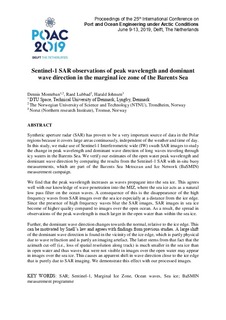| dc.contributor.author | Monteban, Dennis | |
| dc.contributor.author | Lubbad, Raed | |
| dc.contributor.author | Johnsen, Harald | |
| dc.date.accessioned | 2020-02-06T08:02:27Z | |
| dc.date.available | 2020-02-06T08:02:27Z | |
| dc.date.created | 2019-09-12T15:37:32Z | |
| dc.date.issued | 2019 | |
| dc.identifier.issn | 0376-6756 | |
| dc.identifier.uri | http://hdl.handle.net/11250/2639926 | |
| dc.description.abstract | Synthetic aperture radar (SAR) has proven to be a very important source of data in the Polar regions because it covers large areas continuously, independent of the weather and time of day. In this study, we make use of Sentinel-1 Interferometric wide (IW) swath SAR images to study the change in peak wavelength and dominant wave direction of long waves traveling through icy waters in the Barents Sea. We verify our estimates of the open water peak wavelength and dominant wave direction by comparing the results from the Sentinel-1 SAR with in-situ buoy measurements, which are part of the Barents Sea Metocean and Ice Network (BaSMIN) measurement campaign. We find that the peak wavelength increases as waves propagate into the sea ice. This agrees well with our knowledge of wave penetration into the MIZ, where the sea ice acts as a natural low pass filter on the ocean waves. A consequence of this is the disappearance of the high frequency waves from SAR images over the sea ice especially at a distance from the ice edge. Since the presence of high frequency waves blur the SAR images, SAR images in sea ice become of higher quality compared to images over the open ocean. As a result, the spread in observations of the peak wavelength is much larger in the open water than within the sea ice. Further, the dominant wave direction changes towards the normal, relative to the ice edge. This can be motivated by Snell’s law and agrees with findings from previous studies. A large shift of the dominant wave direction is found in the vicinity of the ice edge, which is partly physical due to wave refraction and is partly an imaging artefact. The latter stems from that fact that the azimuth cut-off (i.e., loss of spatial resolution along track) is much smaller in the sea ice than in open water and thus waves that were not visible in images over the open water may appear in images over the sea ice. This causes an apparent shift in wave direction close to the ice edge that is purely due to SAR imaging. We demonstrate this effect with our processed images. | nb_NO |
| dc.language.iso | eng | nb_NO |
| dc.publisher | Port and Ocean Engineering under Arctic Conditions, POAC | nb_NO |
| dc.title | Sentinel-1 sar observations of peak wavelength and dominant wave direction in the marginal ice zone of the barents sea | nb_NO |
| dc.type | Journal article | nb_NO |
| dc.type | Peer reviewed | nb_NO |
| dc.description.version | publishedVersion | nb_NO |
| dc.source.volume | 2019-June | nb_NO |
| dc.source.journal | Proceedings - International Conference on Port and Ocean Engineering under Arctic Conditions | nb_NO |
| dc.identifier.cristin | 1724100 | |
| dc.description.localcode | © 2019 Port and Ocean Engineering under Arctic Conditions. Available at http://www.poac.com/Papers/2019/author_index.htm | nb_NO |
| cristin.unitcode | 194,64,91,0 | |
| cristin.unitname | Institutt for bygg- og miljøteknikk | |
| cristin.ispublished | true | |
| cristin.fulltext | original | |
| cristin.qualitycode | 1 | |
